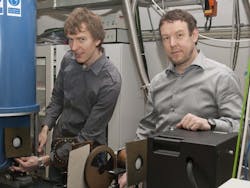Ultrathin semiconductor layer strongly rotates light polarization under a magnetic field
Vienna, Austria--Together with researchers at Würzburg University (Würzburg, Germany), physicists at the Vienna University of Technology have developed a method to control and manipulate the polarization of light via the Faraday effect using ultrathin layers of semiconductor material.1 The experiment can be viewed as the optical version of an electronic transistor and could be a boon to future photonic circuits.
Using long-wave IR light and extremely clean semiconductors, the scientists were able to achieve a Faraday effect orders of magnitude stronger than ever measured before. The semiconductor active layer can be less than a micron thick and, when tuned by an external magnetic field, rotate the polarization of a reflected light beam to any chosen angle. "Such thin layers made of other materials could only change the direction of polarization by a fraction of one degree," says Andrei Pimenov, one of the researchers.
By combining the new device with a polarization filter, light beams can be easily switched between two directions.
An optical transistor
In the experiment, a layer of the semiconductor mercury telluride was irradiated with long-wave IR light. "The light has a frequency in the terahertz domain; those are the frequencies future generations of computers may operate with," Pimenov believes. "For years, the clock rates of computers have not really increased, because a domain has been reached in which material properties just don't play along anymore." A possible solution is to enhance electronic circuits with optical elements. In a transistor, an electric current is controlled by an external signal. In the new device, a beam of light is controlled by an external magnetic field. The two systems are very much alike. "We could call our system a light transistor," Pimenov suggests.
Before optical circuits for computers can be considered, the newly discovered effect should prove useful as a tool for further research. In optics labs, it may play a role in research on new materials and the physics of light.
REFERENCE
1. A. M. Shuvaev et al., Physical Review Letters 106, p. 107404, March 11, 2011.
Subscribe now to Laser Focus World magazine; it’s free!
About the Author
John Wallace
Senior Technical Editor (1998-2022)
John Wallace was with Laser Focus World for nearly 25 years, retiring in late June 2022. He obtained a bachelor's degree in mechanical engineering and physics at Rutgers University and a master's in optical engineering at the University of Rochester. Before becoming an editor, John worked as an engineer at RCA, Exxon, Eastman Kodak, and GCA Corporation.

